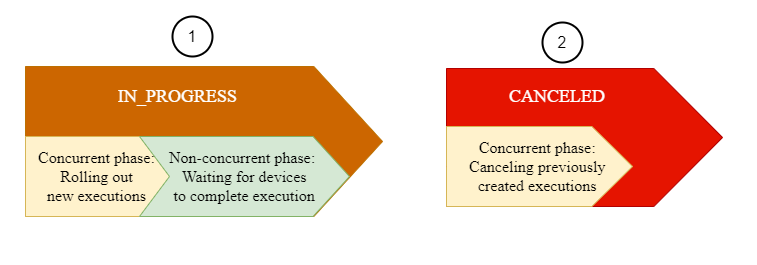Amazon IoT Jobs limits
Amazon IoT Jobs has Service quotas, or limits, that correspond to the maximum number of service resources or operations for your Amazon Web Services account.
Job executions limits
This section provides information about the job execution limits for Amazon IoT Device Management.
Note
These limits are not part of the service quotas that you can find in the Amazon IoT Device Management Service Quotas documentation.
To get information about the number of pending job executions, you can
either use the GetPendingJobExecutions API, or subscribe to the
MQTT reserved topics for Amazon IoT Jobs and receive Job notification types.
The number of pending job executions in your account can vary depending on whether you have the scheduling configuration enabled and use a recurring maintenance window.
| API/notification name | Description | Without scheduling configuration | With scheduling configuration |
|---|---|---|---|
ListNotification |
A ListNotification is published whenever an old job execution
enters a terminal status, or when a new job execution is queued or changes to
a non-terminal status. It can display up to 15 pending job executions that
are either QUEUED or IN_PROGRESS. |
10 | 15 (Up to 5 job executions only appears in the ListNotification
during a maintenace window). |
GetPendingJobExecutions |
When you invoke the
|
10 | 15 |
Active and concurrent job limits
This section will help you learn more about active and concurrent jobs and the limits that apply to them.
Active jobs and active job limit
When you create a job by using the Amazon IoT console or the CreateJob
API, the job status changes to IN_PROGRESS. All in-progress jobs
are active jobs and count towards the active jobs limit.
This includes jobs that are either rolling out new job executions, or jobs that
are waiting for devices to complete their job executions. This limit applies to
both continuous and snapshot jobs.
Concurrent jobs and job concurrency limit
In-progress jobs that are either rolling out new job executions, or jobs that
are canceling previously created job executions are concurrent
jobs and count towards the job concurrency limit. Amazon IoT Jobs can
roll out and cancel job executions swiftly at a rate of 1000 devices per minute.
Each job is concurrent and counts towards the job concurrency limit
only for a short time. After the job executions have been rolled out or
canceled, the job is no longer concurrent and does not count towards the job
concurrency limit. You can use the job concurrency to create a large number of
jobs while waiting for devices to complete the job execution.
Note
If a job with the optional scheduling configuration and job document rollout
scheduled to take place during a maintenance window reaches the selected
startTime and you're at your maximum job concurrency limit,
then that scheduled job will move to a status state of
CANCELED.
To determine whether a job is concurrent, you can use the IsConcurrent property
of a job from the Amazon IoT console, or by using the DescribeJob or ListJob
API. This limit applies to both continuous and snapshot jobs.
To view the active jobs and job concurrency limits and other Amazon IoT Jobs quotas for your Amazon Web Services account and to request a limit increase, see Amazon IoT Device Management endpoints and quotas in the Amazon Web Services General Reference.
The following diagram shows how the job concurrency applies to in-progress jobs and jobs that are being canceled.

Note
New jobs with the optional SchedulingConfig will maintain an
initial status state of SCHEDULED and update to
IN_PROGRESS upon reaching the selected startTime.
After the new job with the optional SchedulingConfig reaches the
selected startTime and updates to IN_PROGRESS, it will
count towards the active jobs limit and job concurrency limit. Jobs with a
status state of SCHEDULED will count towards the active jobs limit,
but will not count towards the job concurrency limit.
The following table shows the limits that apply to active and concurrent jobs and the concurrent and non-concurrent phases of the job states.
| Job status | Phase | Active jobs limit | Job concurrency limit |
|---|---|---|---|
SCHEDULED |
Non-concurrent phase: Amazon IoT Jobs waits for the scheduled
startTime of the job to begin job execution
notifications to your devices. Jobs in this phase only count towards the
active jobs limit and will have the IsConcurrent property
set to false. |
Applies | Does not apply |
IN_PROGRESS |
Concurrent phase: Amazon IoT Jobs accepts the request for creating the job
and starts rolling out job execution notifications to your devices. Jobs
in this phase are concurrent, as denoted by the
IsConcurrent property set to true, and count towards
both the active jobs and the job concurrency limits. |
Applies | Applies |
Non-concurrent phase: Amazon IoT Jobs waits for devices to report the
results of their job executions. Jobs in this phase only count towards
the active jobs limit and will have the IsConcurrent
property set to false. |
Applies | Does not apply | |
Canceled |
Concurrent phase: Amazon IoT Jobs accepts the request for canceling the
job and starts canceling job executions previously created for your
devices. Jobs in this phase are concurrent and will have the
IsConcurrent property set to true. Once the job and job
executions have been canceled, the job is no longer concurrent and does
not count towards the job concurrency limit. |
Does not apply | Applies |
Note
The max duration of a recurring maintenance window is 23 hours, 50 minutes.